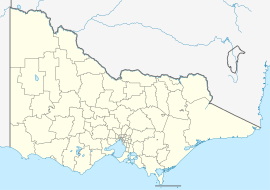Town in Victoria, Australia
| Cape Schanck Victoria | |||||||||
|---|---|---|---|---|---|---|---|---|---|
 Cape Schanck looking towards Pulpit Rock at dawn Cape Schanck looking towards Pulpit Rock at dawn | |||||||||
 | |||||||||
| Coordinates | 38°27′40″S 144°54′18″E / 38.461°S 144.905°E / -38.461; 144.905 | ||||||||
| Population | 569 (2021 census) | ||||||||
| Postcode(s) | 3939 | ||||||||
| Elevation | 79 m (259 ft) | ||||||||
| Location | |||||||||
| LGA(s) | Shire of Mornington Peninsula | ||||||||
| State electorate(s) | Nepean | ||||||||
| Federal division(s) | Flinders | ||||||||
| |||||||||



Cape Schanck, or Tunnahan (Boonwurrung) is a locality at the southernmost tip of the Mornington Peninsula in Melbourne, Victoria, Australia, approximately 72 km (45 mi) south of Melbourne's Central Business District, located within the Shire of Mornington Peninsula local government area. Cape Schanck recorded a population of 569 at the 2021 census.
Cape Schanck separates the wild ocean waters of Bass Strait from the slightly calmer waters of Western Port. The most recognisable symbol of Cape Schanck is the Cape Schanck Lighthouse. The lighthouse was built in 1859 and was the second lighthouse built in Victoria. A prominent rock outcrop is Pulpit Rock and stands out at the very tip of the cape.
Cape Schanck is also home to the RACV Resort Cape Schanck on Boneo Road which includes an eighteen-hole golf course and The National Golf Club on Cups Drive.
British-Australian artist Georgiana McCrae produced many of her paintings at Cape Schanck.
A keen artist–traveller in the Romantic tradition, Nicholas Chevalier concentrated on effects of atmosphere, mood and dramatic lighting in his depictions of the iconic natural wonders he found at Cape Schanck.
History

The traditional Boonwurrung name for the cape is Tunnahan.
The location was given its European name in 1800 after Captain John Schank, R.N. (note spelling with only one 'c') by Lieutenant James Grant sailing on the Lady Nelson. Schank had designed the raised keel (or centreboard) on the Lady Nelson. The spelling of the locality as 'Schanck' (two c's) is a misspelling of Schank. Nicolas Baudin called it Cap Richelieu when he sailed past on the Géographe on 30 March 1802.
Cape Schanck Post Office opened around March 1879 and closed in 1962.
In 1893 a steamship, the SS Alert, sank off the coast at Cape Schanck during a storm. It was rediscovered after 113 years on the ocean floor in June 2007.
Flora and fauna
Albatrosses (black-browed, Chatham, yellow-nosed, etc.) are occasionally spotted off the cliffs as are short-tailed shearwaters (particularly during their spring migration), black-faced and pied cormorants, kelp gulls and Australasian gannets. The shrubs decorating the area are frequently home to brown thornbills, singing honeyeaters and a number of other passerines. The elusive striated fieldwren has also been known to inhabit the area. Some flora include cushion bushes.
 Panorama view of Cape Schanck
Panorama view of Cape Schanck
See also
- Shire of Flinders – Cape Schanck was previously within this former local government area.
References and notes
- ^ Australian Bureau of Statistics (28 June 2022). "Cape Schanck (Suburbs and Localities)". 2021 Census QuickStats. Retrieved 11 July 2022.

- "Cape Schanck Lighthouse". Lighthouses of Victoria. Lighthouses of Australia Inc.
- Golf Select, RACV Cape Schanck, retrieved 11 May 2009
- Golf Select, The National, retrieved 11 May 2009
- Nicholas Chevalier (1860s). "Pulpit Rock, Cape Schanck, Victoria". Retrieved 31 August 2017 – via Art Gallery of New South Wales.
- Clark, Ian D. (2002). Dictionary of Aboriginal placenames of Victoria. Melbourne: Victorian Aboriginal Corp. for Languages. p. 54. ISBN 9780957936065.
- Grant, James (1803), The narrative of a voyage of discovery, performed in His Majesty's vessel the Lady Nelson, London: Roworth, p. 195, cited in Bird (2006)
- Lee, Ida (1915), The Logbooks of the Lady Nelson, London: Grafton, p. 328, OL 6580132M
- Great Britain. Hydrographic Dept., Chart of Western Port and coast to Wilson's Promontory forming part of the North side of Bass's Strait [cartographic material] / surveyed by order of Governor King by Ensign Barrallier in HM armed surveying vessel Lady Nelson; Lieut. James Grant, Commander, in March, April and May, 1801., retrieved 11 February 2011
- Bird, Eric (12 October 2006). "Place Names on the Coast of Victoria" (PDF). The Australian National Placename Survey (ANPS). Archived from the original (PDF) on 18 February 2011. Retrieved 23 July 2008.
- Baudin, Nicolas; Cornell, Christine (1974), Journal of Nicolas Baudin, Adelaide: Libraries Board of South Australia, p. 609, ISBN 0-7243-0043-0, cited in Bird (2006)
- Phoenix Auctions History, Post Office List, retrieved 7 February 2021
External links
- Website for Cape Schanck Lighthouse
| Localities in the Shire of Mornington Peninsula | ||
|---|---|---|
| City |  | |
| Town |
| |
| Locality | ||
| ^ - Territory divided with another LGA | ||